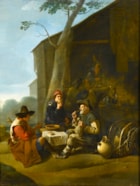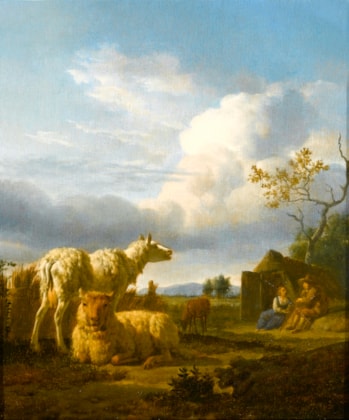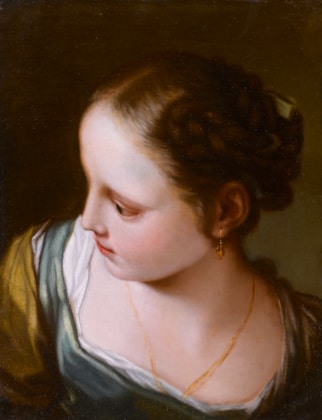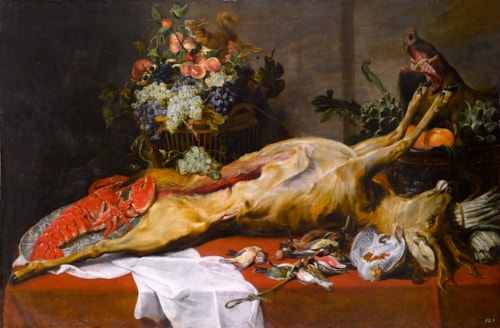ohannes Lingelbach
(Frankfurt 1622 - Amsterdam 1674)
Peasants Resting Before an Inn
oil on canvas
49.6 x 38.7 cm (19½ x 15¼ in)
In this work Johannes Lingelbach has depicted three peasants recuperating and refreshing themselves by an inn. These figures sit, eating and drinking, around a low table covered with a white cloth, on which a bowl and a chunk of bread have been placed. The eldest of the figures drinks deeply while clutching a flagon, ready to immediately refill his glass; this thirst suggests that they had a tiring journey. There is a lack of conversation between the figures, as they concentrate instead on rejuvenating themselves. Behind them, two horses water at a trough. The central group is meticulously depicted, particularly in terms of Lingelbach’s use of light. The stark, white sunshine highlights the figures, models their faces, and picks out the folds in their clothing. This light also plays off various objects, such as the saddle, the large ceramic jug and the table top, giving an almost still-life aspect to the painting in this central, foreground section.
The inn dominates the canvas, so that there is a relative lack of depth to the Peasants Resting Before an Inn, although on the left-hand side a figure can be discerned, walking along a path and beyond him the outline of another building. In terms of composition the present work is reminiscent of other paintings by Lingelbach, such as Roman Street Scene with Card Players. Again a lack of recession focuses the work on a few leisurely foreground figures, the background details are indistinct. The scene is also illuminated by a similar stark light to the present work and these dramatic contrasts are reflective of the time Lingelbach spent in Rome, where he was influenced by the fashion for precise but intense chiaroscuro.
Peasants Resting Before an Inn demonstrates Lingelbach’s skill in depicting the human figure, something which is demonstrated on a greater scale in Peasants Dancing. In this painting we see a variety of figures, including musicians, dancers, drunks, lovers, workers and children. All these figures are treated in the same detailed and individualised manner which is employed in the present work. Lingelbach was part of the second generation of the bamboccianti, a group of, mainly Dutch, genre painters active in Rome during the seventeenth century, who chronicled the everyday life of the lower-classes. Having found commercial success through such works, on his return to Amsterdam Lingelbach helped develop the ‘Italianate’ genre that was imitated by Dutch artists who had never been to Italy. Such was his skill in painting genre figures, that Lingelbach was often invited to paint the staffage for prominent Dutch artists, such as Jacob van Ruisdael (1628/9-1682), Meindert Hobbema (1638-1709) and Jan Wijnants (c.1635-1684).
sale, Sotheby's London, 24 October 1973, lot 43, as Jan Miel;
Private Collection New York;
with Richard L. Feigen & co., New York.
Catja Burger-Wegener, Johannes Lingelbach,1622-1674, Ph.D. diss., Freie Universität, Berlin, 1976, no. 106.
In this work Johannes Lingelbach has depicted three peasants recuperating and refreshing themselves by an inn. These figures sit, eating and drinking, around a low table covered with a white cloth, on which a bowl and a chunk of bread have been placed. The eldest of the figures drinks deeply while clutching a flagon, ready to immediately refill his glass; this thirst suggests that they had a tiring journey. There is a lack of conversation between the figures, as they concentrate instead on rejuvenating themselves. Behind them, two horses water at a trough. The central group is meticulously depicted, particularly in terms of Lingelbach’s use of light. The stark, white sunshine highlights the figures, models their faces, and picks out the folds in their clothing. This light also plays off various objects, such as the saddle, the large ceramic jug and the table top, giving an almost still-life aspect to the painting in this central, foreground section.
The inn dominates the canvas, so that there is a relative lack of depth to the Peasants Resting Before an Inn, although on the left-hand side a figure can be discerned, walking along a path and beyond him the outline of another building. In terms of composition the present work is reminiscent of other paintings by Lingelbach, such as Roman Street Scene with Card Players. Again a lack of recession focuses the work on a few leisurely foreground figures, the background details are indistinct. The scene is also illuminated by a similar stark light to the present work and these dramatic contrasts are reflective of the time Lingelbach spent in Rome, where he was influenced by the fashion for precise but intense chiaroscuro.
Peasants Resting Before an Inn demonstrates Lingelbach’s skill in depicting the human figure, something which is demonstrated on a greater scale in Peasants Dancing. In this painting we see a variety of figures, including musicians, dancers, drunks, lovers, workers and children. All these figures are treated in the same detailed and individualised manner which is employed in the present work. Lingelbach was part of the second generation of the bamboccianti, a group of, mainly Dutch, genre painters active in Rome during the seventeenth century, who chronicled the everyday life of the lower-classes. Having found commercial success through such works, on his return to Amsterdam Lingelbach helped develop the ‘Italianate’ genre that was imitated by Dutch artists who had never been to Italy. Such was his skill in painting genre figures, that Lingelbach was often invited to paint the staffage for prominent Dutch artists, such as Jacob van Ruisdael (1628/9-1682), Meindert Hobbema (1638-1709) and Jan Wijnants (c.1635-1684).
sale, Sotheby's London, 24 October 1973, lot 43, as Jan Miel;
Private Collection New York;
with Richard L. Feigen & co., New York.
Catja Burger-Wegener, Johannes Lingelbach,1622-1674, Ph.D. diss., Freie Universität, Berlin, 1976, no. 106.




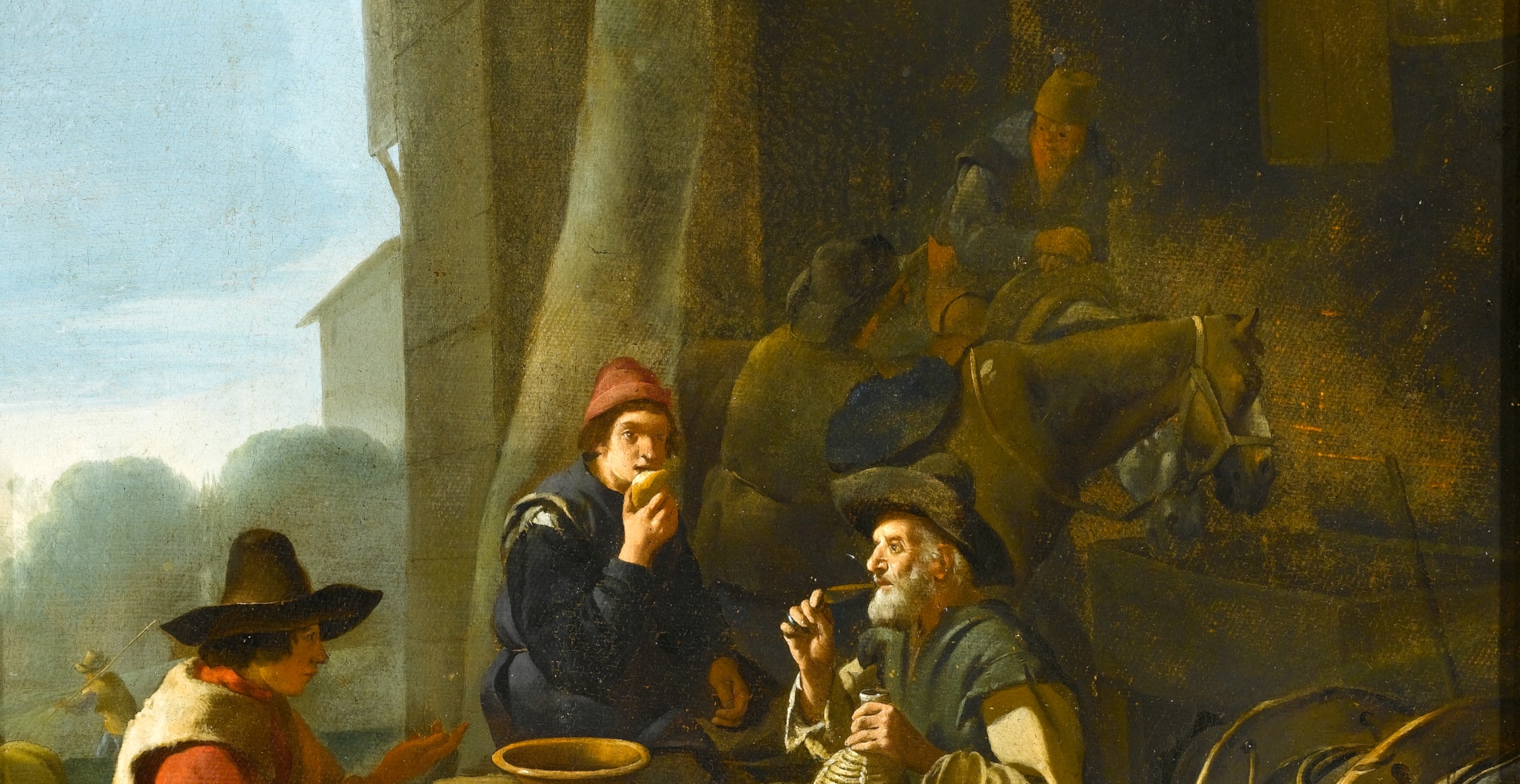
 contact
contact contact
contact +44 20 7313 8040
+44 20 7313 8040